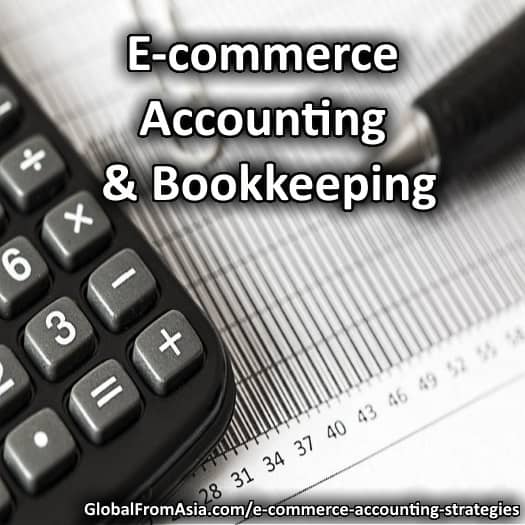
One vital aspect of a business is accounting. As they say, accounting is the backbone of a business; without it, a business simply won’t work. Accounting keeps everything together, and gives you a clear picture of how your business is doing financially.
As technology progresses, most businesses are being run online, and accounting may not follow traditional methods. Fortunately, today accounting can be done automatically with some software – it has totally transformed into a seamless system.
Whether you opt for automated bookkeeping solutions or opt for a DIY approach, it’s important to familiarize yourself with every corner of accounting to easily check the progress of the business, identify how to generate more sales, and legally comply with the IRS or local tax authorities.
How to Do Accounting for E-commerce

If you opt for a DIY accounting approach, you may find the following steps helpful:
- Apply for a business bank account – First things first, you will need a business bank account for clean and accurate bookkeeping. Using your personal bank account can make it harder for you to organize your affairs efficiently, especially when filing your taxes and fees. Requirements for a business bank account vary depending on the type of business, but the most common requirements are: valid ID, tax identification number, and social security number.
- Know your taxes – To be honest, taxes can be difficult to understand. For many, it can be intimidating. However, taxes are unavoidable, so if you want to keep your business, you have to abide by the law and pay your taxes. Tax is an immense topic, but to cut it short, you’ll have to register for a sales tax permit, collect sales tax, and file sales tax semi-annually/annually. To know more about it, here’s an in depth article about Taxes for E-commerce.
- Track every penny – Keep all the receipts, invoices, bank statements, proof of payments, financial statements, previous tax returns and any other financial records. This will make it easier to track and monitor your finances, and also to legally comply with the IRS. As most everything is paperless now, filing must still be done electronically.
- Track how much money your business makes – Assessing how much money your business makes is a relatively simple process of adding and subtracting. First, identify and list all the money you receive from the business. Next, list all the expenses, including the cost of merchandise, warehouse or office rental, etc. Lastly, deduct expenses from income. If your expenses outpace your income, your business is obviously not making money.
- Bookkeeping (payables, receivables, sales monitoring, inventory) – There’s more to accounting than numbers and math, and business doesn’t simply end at making sales. At the end of the day, you’ll have to do the following:
- Record daily financial transactions in a ledger or journal
- Keep track of the company’s payables (utilities, office supplies, marketing expenses, etc.)
- Keep track of receivables (money owed to your company by customers)
- Monitor sales – Identify which products/services create more sales and which don’t
- Monitor inventory – Make sure to maintain the right balance of stock, meaning, your inventory shouldn’t exceed nor be insufficient in order to avoid cash flow fluctuations.
E-commerce Accounting Strategies

Keeping good accounting records for an e-commerce business may be a challenge – and it may be the least fun thing to do in keeping up a business – but if you want your business to grow and flourish, take note of the following accounting strategies:
1. Keep business and personal transactions separate.
2. Take advantage of automated accounting solutions.
There are hundreds of companies offering accounting solutions, here are a few:
Kashoo.com: For $16.65/month, you get to create and send branded invoices, track and store expenses, create and download reports, easily reconcile bank data, and easily monitor how your business is doing financially.
Quickbooks: Pricing starts at $5 per month. Features include: track income and expenses, invoicing and accepting payments, run reports, track sales and sales tax, and track inventory.
Wave: Known for its 100% web-based free software. It includes invoicing, accounting and receipt scanning.
3. Do extensive research and speak to a tax advisor to fully understand how much tax you should be paying.
4. Let’s face it, almost every business owner loathes bookkeeping. If all else fails, outsource or hire an in-house bookkeeper/CPA. Especially when you feel your business is quickly growing, you might want to hire a bookkeeper/CPA to help you catch up on other important things.
5. E-commerce accounting is a lot easier with e-commerce platforms like Shopify. If you’re just starting, consider Shopify as your e-commerce platform.
E-commerce Accounting Challenges

E-commerce accounting isn’t always sunshine and rainbows – obstacles are just inevitable. Here are some accounting challenges you should not overlook:
1. Sales Tax: Surely, you have heard of the word “nexus.” Basically, even if your business only operates online, you are not exempted from taxes. This is one of the most common accounting challenges one has to face – especially to a business that has multiple channels. Calculating sales tax from multiple states can be a real headache.
2. Non-synchronized Accounting Methods: Keeping up with stock, inventory, and sales can be cumbersome – especially if there’s no synchronization. This happens most commonly to e-commerce businesses that lack manpower and communication.
3. Cash Receipt Reconciliation: It’s vital to have accuracy and consistency in financial accounts; hence, consistent cash receipt reconciliation is recommended for any businesses. However, almost all e-commerce companies work with payment gateways to collect payments from their customers. Each payment gateway has different settlement times and it may be a pain to reconcile all cash receipts in real time.
4. Back-end Accounting/Inventory/Processing System: Because your business is online, you probably rely on various systems to automate accounting. Because of this, it may be challenging to quickly see how the business is doing financially, especially if these systems don’t seamlessly integrate with one another.
